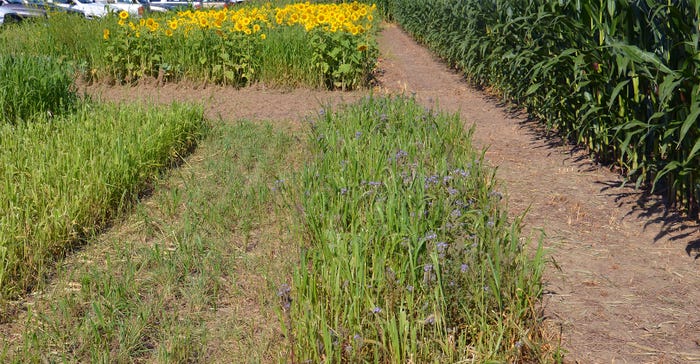
Mike Werling started out using just a few species when he first tried cover crops. There are still fields where he seeds two or three cover crop species. They are selected for a reason, often for erosion control or to scavenge nitrogen, the Decatur, Ind., farmer says. But when he has an opportunity, he will mix a multitude of species together, trying to achieve maximum benefits from cover crops. Some people call them cocktail mixes.
Werling has blended as many as 14 species together, but he acknowledges that he only does that in certain situations. “For example, I raised and combined oats this year,” he explains. “Then I could go in and plant cover crops earlier than if I was sowing them into a standing crop before harvest or aerial seeding them.”
There are certain species that need to be seeded early to get enough growth in the fall to be effective. Some winterkill in a normal winter, especially in northern Indiana. They provide their benefit in the fall. Others overwinter and grow in the spring, but they need enough time to get established in the fall so they have enough energy reserves to make it through winter.
Specific purpose
Werling believes it’s important to know why you add each species to a mix. Some are good at scavenging nitrogen left over by the current corn crop. Others, like crimson clover, can produce a sizable amount of nitrogen if allowed to grow long enough in the spring.
Alan Dean, who operates Dean Farms with his brother near Bryan, Ohio, also believes there is value in having a diversity of plants with different root systems in the field. Diversity of vegetation helps promote diversity of microorganisms that live in the soil. They are the drivers for soil health.
Dean, Werling and others guided visitors through various cover crop plots that were established for demonstration purposes at Remke Farms near Harlan, Ind., earlier this summer. The plots were one of the highlights of the Allen County Soil and Water Conservation District field day held there.
“One thing you need to do is have a plan to kill each species of cover crop before you add it to the mix and seed it,” Werling says. “Some winterkill, but others don’t and must be terminated in the spring. For example, you need to be sure you understand how to terminate annual ryegrass before you seed it.”
Take a virtual tour of the Remke plots by checking out the slideshow below. Ratings and other information about these species is based on the Midwest Cover Crops Field Guide, ID-433. Look for the second half of this virtual tour here, on Friday, Sept. 1.
About the Author(s)
You May Also Like




